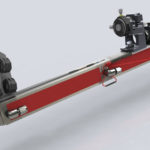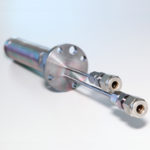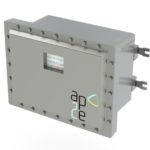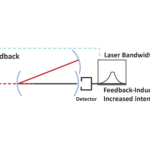CEMGAS 5000 CO2 Laser Analyzer
By AP2E
The CEMGAS 5000 CO2 Laser Analyzer is a complete pre-calibrated laser infrared spectrometer for carbon dioxide analysis. It contains patented Optical Feedback Cavity Enhanced Absorption Spectroscopy (OFCEAS) IR technology. This low-cost innovative laser analyzer offers enhanced specificity, selectivity, accuracy and stability.
Overview
Why choose the CEMGAS 5000 CO2 Laser Analyzer?
The CEMGAS 5000 CO2 Laser Analyzer comes pre-calibrated for your application. This robustly build machine was built strictly for industrial and on-board mobile applications and contains no optical moving parts.
Regardless of the matrix, the OFCEAS IR technology associated with low-pressure sampling provides exceptional selectivity, enabling simultaneous multi-component measurements without interferences. The technology removes any risk for chemicals adsorption/desorption and condensation in the line.
Initially packaged in a standard 19” rack (optional wall mount) the OFCEAS technology associated with low pressure sampling enables direct measurement. It has a minimum Level of Detection (LOD) of 2 ppm allowing for atmospheric safety measures to be met and exceeded.
In addition to containing no moving optical components, the IR sources (telecom type laser) are characterized by high MTBF’s of 5 years. There is no re-zero or drift because the zero information is contained in the signal, enabling automated and intrinsic re-zero of the analyzer.
Contact a Cemtek representative today to discuss how the CEMGAS 5000 CO2 Laser Analyzer can fit into your company’s plan to limit it’s carbon pollution at an affordable cost.
What is CO2 and why does it need to be measured?
CO2 or carbon dioxide is usually found in its gaseous state and is vital to life on Earth. At low concentrations, it is odorless while at higher concentrations it has a sharp, acidic odor. In its solid state it is commonly called dry ice.
There are both natural and human sources of carbon dioxide emissions. Natural sources include ocean release, respiration and decomposition. Human sources of CO2 come from activities like deforestation, cement production, and the burning of fossil fuels such as oil, coal and natural gas.
CO2 is the primary greenhouse gas emitted through human activities. In 2011, fossil fuel use created 33.2 billion tonnes of carbon dioxide emissions worldwide and in 2014, it accounted for about 80.9% of all U.S. greenhouse gas emissions from human activities.
Anthropogenic CO2 acts as a dangerous pollutant due to its impacts on global warming and climate change, as well as its major effect on marine ecosystems through ocean acidification.
Although normal levels of CO2 are considered harmless, under the right conditions, such as confined areas, it can cause adverse health effects. CO2 content in fresh air varies between 0.036% (360 ppm) and 0.041% (410 ppm), depending on the location.
In concentrations up to 1% (10,000 ppm), it will make some people feel drowsy and produce a heavy feeling in the lungs. A 30-minute exposure at 50,000 ppm will produce signs of intoxication and just a few minutes of exposure at 70,000 to 100,000 ppm can cause loss of consciousness. 100,000 ppm is the atmospheric concentration immediately dangerous to life.
The National Institute for Occupational Safety and Health (NIOSH) sets the REL level at 5,000 ppm (.5%) TWA matching that of OSHA's PEL.
Under the Supreme Court decision in Massachusetts v. EPA, greenhouse gases (CO2 being one of them) meet the definition of air pollutants under the Clean Air Act and therefore must be regulated. Adequate monitoring of carbon dioxide levels is necessary to help maintain the safety, health and welfare of the public and the environment.
Applications
Power Generation
Greenhouse Gas Monitoring
CO2 Sequestration
Carbon Capture
CEMS
Compliance Monitoring
Refineries
Trace Level CO2 Monitoring









